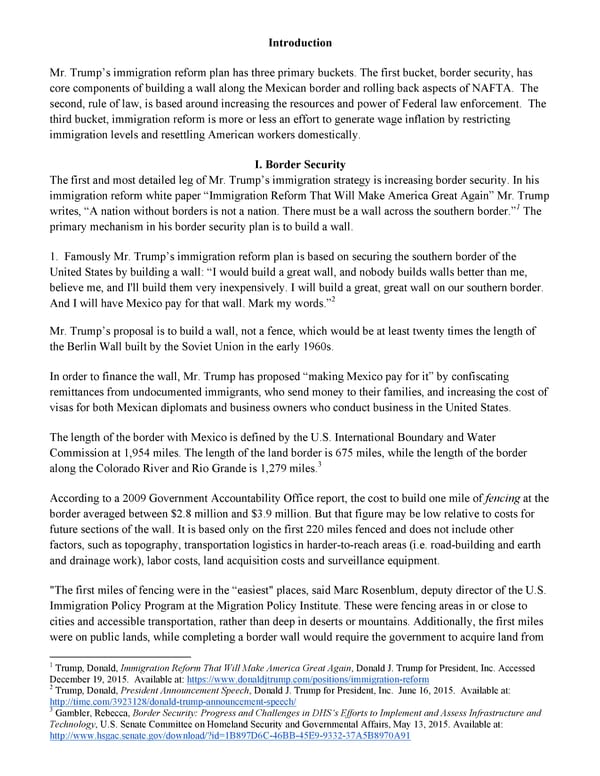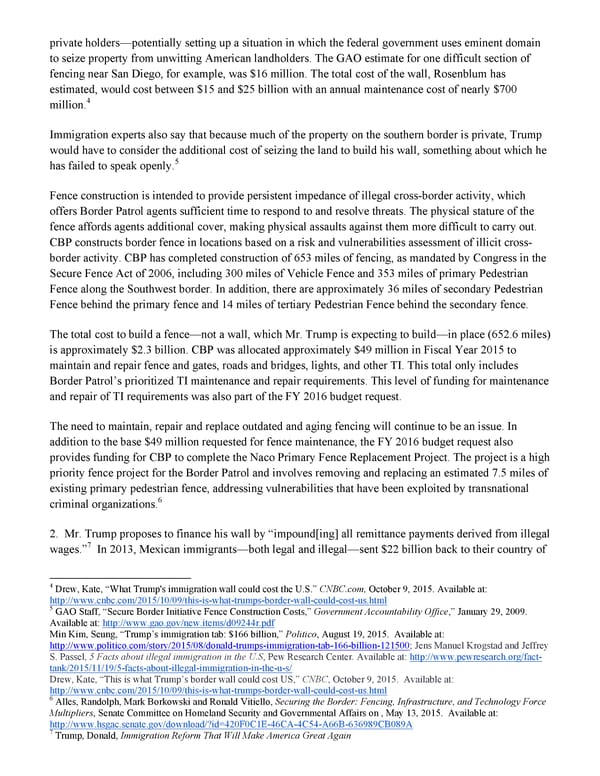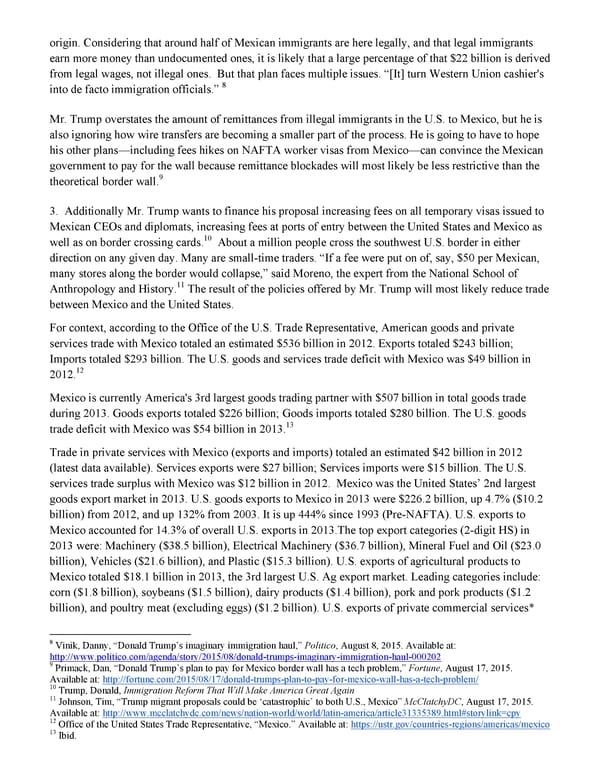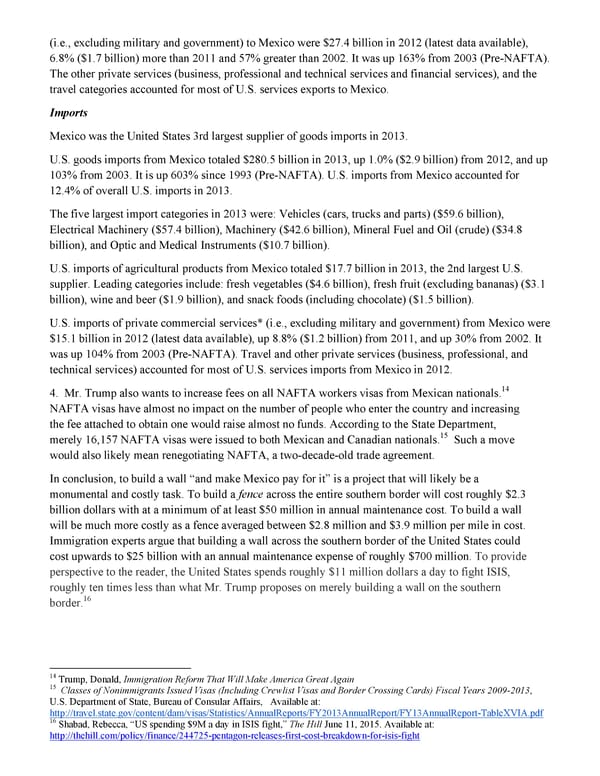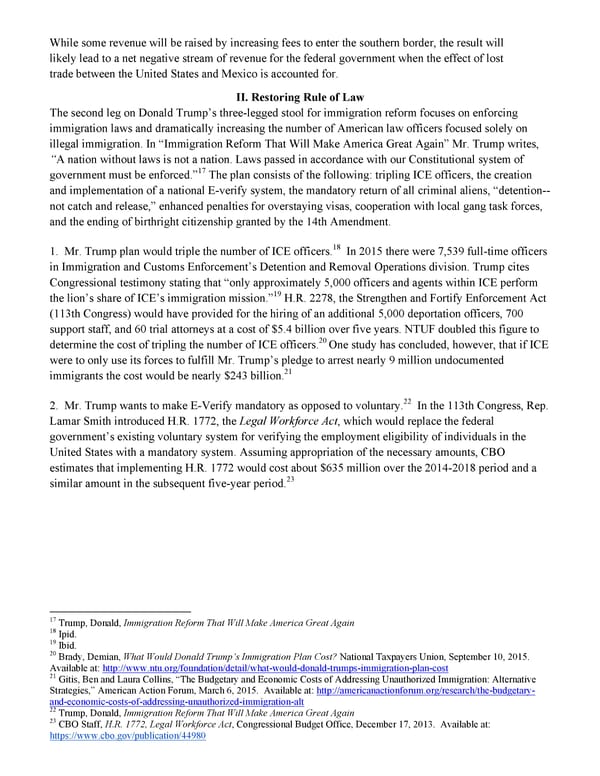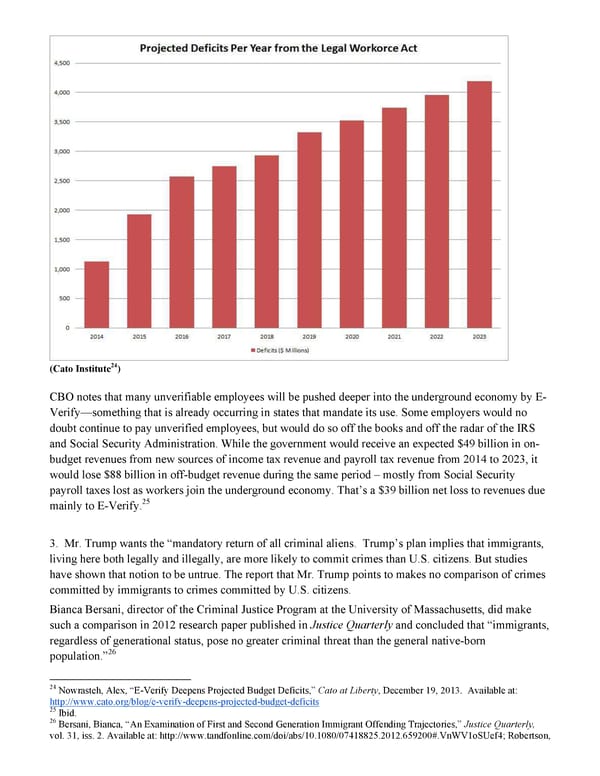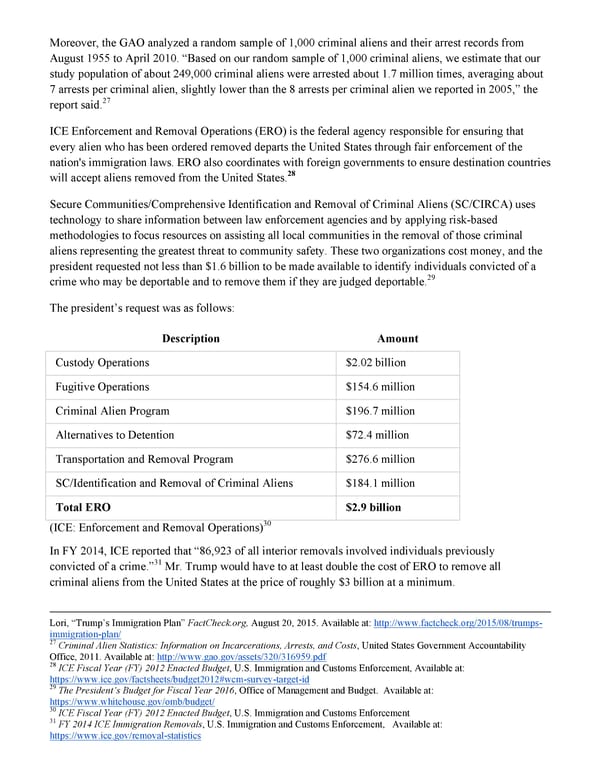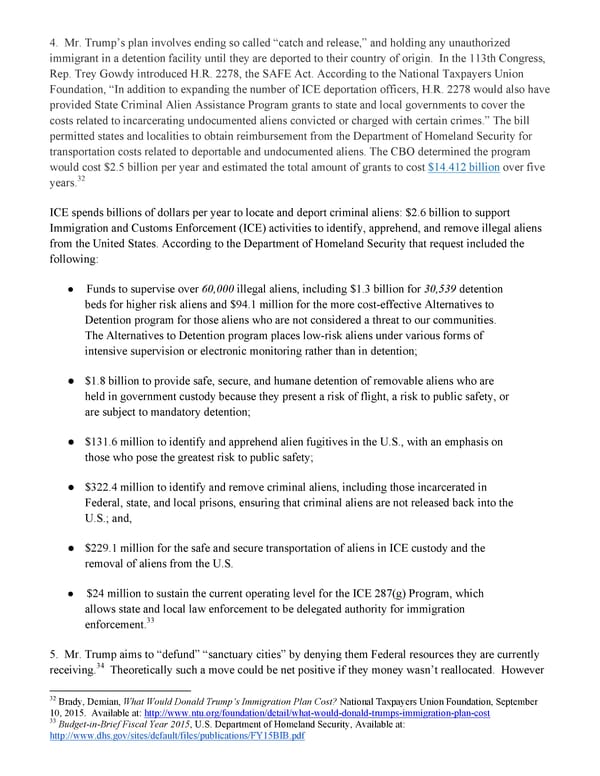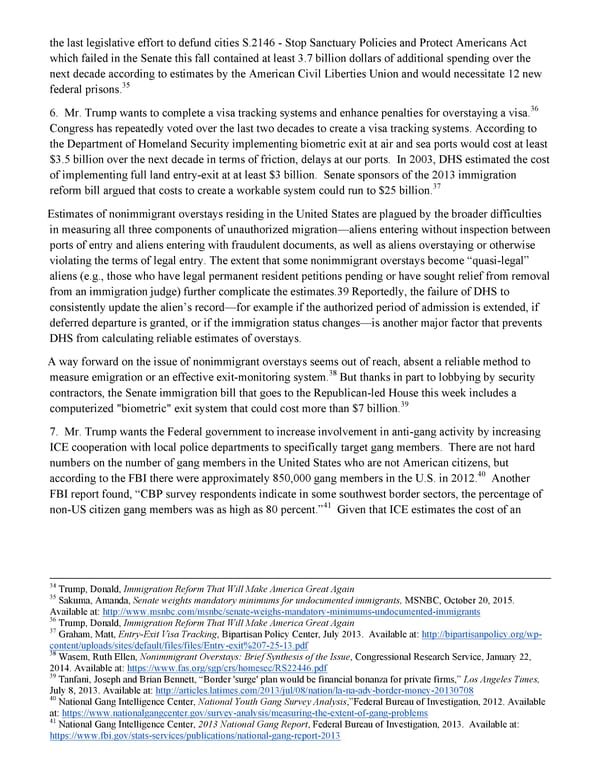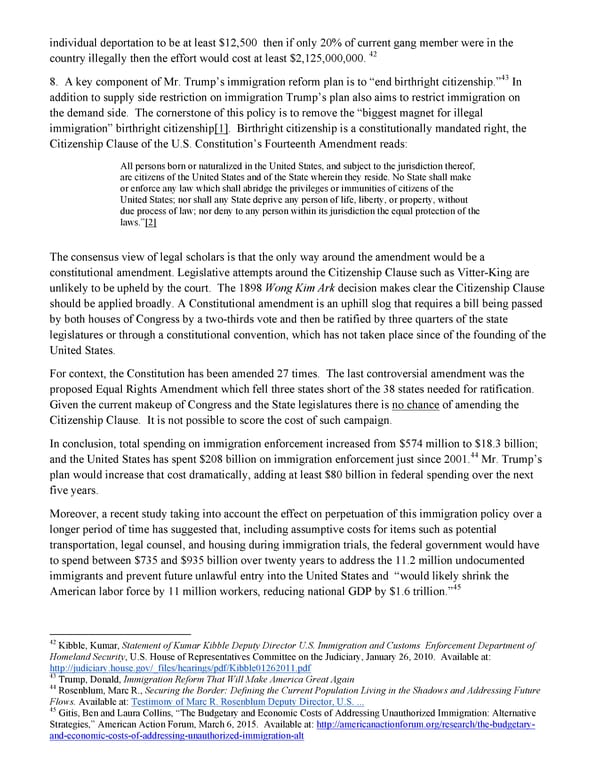THE $900 BILLION QUESTION: ILLEGAL IMMIGRATION
THE $900 BILLION QUESTION: HOW TO ADDRESS ILLEGAL IMMIGRATION IN AMERICA A Complete Fiscal Analysis Of Donald J. Trump’s Immigration Reform Plan By Mark McIntosh & Steven Bogden January 2016
Introduction Mr. Trump’s immigration reform plan has three primary buckets. The first bucket, border security, has core components of building a wall along the Mexican border and rolling back aspects of NAFTA. The second, rule of law, is based around increasing the resources and power of Federal law enforcement. The third bucket, immigration reform is more or less an effort to generate wage inflation by restricting immigration levels and resettling American workers domestically. I. Border Security The first and most detailed leg of Mr. Trump’s immigration strategy is increasing border security. In his immigration reform white paper “Immigration Reform That Will Make America Great Again” Mr. Trump writes, “A nation without borders is not a nation. There must be a wall across the southern border.”1 The primary mechanism in his border security plan is to build a wall. 1. Famously Mr. Trump’s immigration reform plan is based on securing the southern border of the United States by building a wall: “I would build a great wall, and nobody builds walls better than me, believe me, and I'll build them very inexpensively. I will build a great, great wall on our southern border. 2 And I will have Mexico pay for that wall. Mark my words.” Mr. Trump’s proposal is to build a wall, not a fence, which would be at least twenty times the length of the Berlin Wall built by the Soviet Union in the early 1960s. In order to finance the wall, Mr. Trump has proposed “making Mexico pay for it” by confiscating remittances from undocumented immigrants, who send money to their families, and increasing the cost of visas for both Mexican diplomats and business owners who conduct business in the United States. The length of the border with Mexico is defined by the U.S. International Boundary and Water Commission at 1,954 miles. The length of the land border is 675 miles, while the length of the border 3 along the Colorado River and Rio Grande is 1,279 miles. According to a 2009 Government Accountability Office report, the cost to build one mile of fencing at the border averaged between $2.8 million and $3.9 million. But that figure may be low relative to costs for future sections of the wall. It is based only on the first 220 miles fenced and does not include other factors, such as topography, transportation logistics in harder-to-reach areas (i.e. road-building and earth and drainage work), labor costs, land acquisition costs and surveillance equipment. "The first miles of fencing were in the “easiest" places, said Marc Rosenblum, deputy director of the U.S. Immigration Policy Program at the Migration Policy Institute. These were fencing areas in or close to cities and accessible transportation, rather than deep in deserts or mountains. Additionally, the first miles were on public lands, while completing a border wall would require the government to acquire land from 1 Trump, Donald, Immigration Reform That Will Make America Great Again, Donald J. Trump for President, Inc. Accessed December 19, 2015. Available at: https://www.donaldjtrump.com/positions/immigration-reform 2 Trump, Donald, President Announcement Speech, Donald J. Trump for President, Inc. June 16, 2015. Available at: http://time.com/3923128/donald-trump-announcement-speech/ 3 Gambler, Rebecca, Border Security: Progress and Challenges in DHS’s Efforts to Implement and Assess Infrastructure and Technology, U.S. Senate Committee on Homeland Security and Governmental Affairs, May 13, 2015. Available at: http://www.hsgac.senate.gov/download/?id=1B897D6C-46BB-45E9-9332-37A5B8970A91
private holders—potentially setting up a situation in which the federal government uses eminent domain to seize property from unwitting American landholders. The GAO estimate for one difficult section of fencing near San Diego, for example, was $16 million. The total cost of the wall, Rosenblum has estimated, would cost between $15 and $25 billion with an annual maintenance cost of nearly $700 million.4 Immigration experts also say that because much of the property on the southern border is private, Trump would have to consider the additional cost of seizing the land to build his wall, something about which he 5 has failed to speak openly. Fence construction is intended to provide persistent impedance of illegal cross-border activity, which offers Border Patrol agents sufficient time to respond to and resolve threats. The physical stature of the fence affords agents additional cover, making physical assaults against them more difficult to carry out. CBP constructs border fence in locations based on a risk and vulnerabilities assessment of illicit cross- border activity. CBP has completed construction of 653 miles of fencing, as mandated by Congress in the Secure Fence Act of 2006, including 300 miles of Vehicle Fence and 353 miles of primary Pedestrian Fence along the Southwest border. In addition, there are approximately 36 miles of secondary Pedestrian Fence behind the primary fence and 14 miles of tertiary Pedestrian Fence behind the secondary fence. The total cost to build a fence—not a wall, which Mr. Trump is expecting to build—in place (652.6 miles) is approximately $2.3 billion. CBP was allocated approximately $49 million in Fiscal Year 2015 to maintain and repair fence and gates, roads and bridges, lights, and other TI. This total only includes Border Patrol’s prioritized TI maintenance and repair requirements. This level of funding for maintenance and repair of TI requirements was also part of the FY 2016 budget request. The need to maintain, repair and replace outdated and aging fencing will continue to be an issue. In addition to the base $49 million requested for fence maintenance, the FY 2016 budget request also provides funding for CBP to complete the Naco Primary Fence Replacement Project. The project is a high priority fence project for the Border Patrol and involves removing and replacing an estimated 7.5 miles of existing primary pedestrian fence, addressing vulnerabilities that have been exploited by transnational criminal organizations.6 2. Mr. Trump proposes to finance his wall by “impound[ing] all remittance payments derived from illegal 7 wages.” In 2013, Mexican immigrants—both legal and illegal—sent $22 billion back to their country of 4 Drew, Kate, “What Trump's immigration wall could cost the U.S.” CNBC.com, October 9, 2015. Available at: http://www.cnbc.com/2015/10/09/this-is-what-trumps-border-wall-could-cost-us.html 5 GAO Staff, “Secure Border Initiative Fence Construction Costs,” Government Accountability Office,” January 29, 2009. Available at: http://www.gao.gov/new.items/d09244r.pdf Min Kim, Seung, “Trump’s immigration tab: $166 billion,” Politico, August 19, 2015. Available at: http://www.politico.com/story/2015/08/donald-trumps-immigration-tab-166-billion-121500; Jens Manuel Krogstad and Jeffrey S. Passel, 5 Facts about illegal immigration in the U.S, Pew Research Center. Available at: http://www.pewresearch.org/fact- tank/2015/11/19/5-facts-about-illegal-immigration-in-the-u-s/ Drew, Kate, “This is what Trump’s border wall could cost US,” CNBC, October 9, 2015. Available at: http://www.cnbc.com/2015/10/09/this-is-what-trumps-border-wall-could-cost-us.html 6 Alles, Randolph, Mark Borkowski and Ronald Vitiello, Securing the Border: Fencing, Infrastructure, and Technology Force Multipliers, Senate Committee on Homeland Security and Governmental Affairs on , May 13, 2015. Available at: http://www.hsgac.senate.gov/download/?id=420F0C1E-46CA-4C54-A66B-636989CB089A 7 Trump, Donald, Immigration Reform That Will Make America Great Again
origin. Considering that around half of Mexican immigrants are here legally, and that legal immigrants earn more money than undocumented ones, it is likely that a large percentage of that $22 billion is derived from legal wages, not illegal ones. But that plan faces multiple issues. “[It] turn Western Union cashier's 8 into de facto immigration officials.” Mr. Trump overstates the amount of remittances from illegal immigrants in the U.S. to Mexico, but he is also ignoring how wire transfers are becoming a smaller part of the process. He is going to have to hope his other plans—including fees hikes on NAFTA worker visas from Mexico—can convince the Mexican government to pay for the wall because remittance blockades will most likely be less restrictive than the theoretical border wall.9 3. Additionally Mr. Trump wants to finance his proposal increasing fees on all temporary visas issued to Mexican CEOs and diplomats, increasing fees at ports of entry between the United States and Mexico as 10 well as on border crossing cards. About a million people cross the southwest U.S. border in either direction on any given day. Many are small-time traders. “If a fee were put on of, say, $50 per Mexican, many stores along the border would collapse,” said Moreno, the expert from the National School of 11 Anthropology and History. The result of the policies offered by Mr. Trump will most likely reduce trade between Mexico and the United States. For context, according to the Office of the U.S. Trade Representative, American goods and private services trade with Mexico totaled an estimated $536 billion in 2012. Exports totaled $243 billion; Imports totaled $293 billion. The U.S. goods and services trade deficit with Mexico was $49 billion in 12 2012. Mexico is currently America's 3rd largest goods trading partner with $507 billion in total goods trade during 2013. Goods exports totaled $226 billion; Goods imports totaled $280 billion. The U.S. goods 13 trade deficit with Mexico was $54 billion in 2013. Trade in private services with Mexico (exports and imports) totaled an estimated $42 billion in 2012 (latest data available). Services exports were $27 billion; Services imports were $15 billion. The U.S. services trade surplus with Mexico was $12 billion in 2012. Mexico was the United States’ 2nd largest goods export market in 2013. U.S. goods exports to Mexico in 2013 were $226.2 billion, up 4.7% ($10.2 billion) from 2012, and up 132% from 2003. It is up 444% since 1993 (Pre-NAFTA). U.S. exports to Mexico accounted for 14.3% of overall U.S. exports in 2013.The top export categories (2-digit HS) in 2013 were: Machinery ($38.5 billion), Electrical Machinery ($36.7 billion), Mineral Fuel and Oil ($23.0 billion), Vehicles ($21.6 billion), and Plastic ($15.3 billion). U.S. exports of agricultural products to Mexico totaled $18.1 billion in 2013, the 3rd largest U.S. Ag export market. Leading categories include: corn ($1.8 billion), soybeans ($1.5 billion), dairy products ($1.4 billion), pork and pork products ($1.2 billion), and poultry meat (excluding eggs) ($1.2 billion). U.S. exports of private commercial services* 8 Vinik, Danny, “Donald Trump’s imaginary immigration haul,” Politico, August 8, 2015. Available at: http://www.politico.com/agenda/story/2015/08/donald-trumps-imaginary-immigration-haul-000202 9 Primack, Dan, “Donald Trump’s plan to pay for Mexico border wall has a tech problem,” Fortune, August 17, 2015. Available at: http://fortune.com/2015/08/17/donald-trumps-plan-to-pay-for-mexico-wall-has-a-tech-problem/ 10 Trump, Donald, Immigration Reform That Will Make America Great Again 11 Johnson, Tim, “Trump migrant proposals could be ‘catastrophic’ to both U.S., Mexico” McClatchyDC, August 17, 2015. Available at: http://www.mcclatchydc.com/news/nation-world/world/latin-america/article31335389.html#storylink=cpy 12 Office of the United States Trade Representative, “Mexico.” Available at: https://ustr.gov/countries-regions/americas/mexico 13 Ibid.
(i.e., excluding military and government) to Mexico were $27.4 billion in 2012 (latest data available), 6.8% ($1.7 billion) more than 2011 and 57% greater than 2002. It was up 163% from 2003 (Pre-NAFTA). The other private services (business, professional and technical services and financial services), and the travel categories accounted for most of U.S. services exports to Mexico. Imports Mexico was the United States 3rd largest supplier of goods imports in 2013. U.S. goods imports from Mexico totaled $280.5 billion in 2013, up 1.0% ($2.9 billion) from 2012, and up 103% from 2003. It is up 603% since 1993 (Pre-NAFTA). U.S. imports from Mexico accounted for 12.4% of overall U.S. imports in 2013. The five largest import categories in 2013 were: Vehicles (cars, trucks and parts) ($59.6 billion), Electrical Machinery ($57.4 billion), Machinery ($42.6 billion), Mineral Fuel and Oil (crude) ($34.8 billion), and Optic and Medical Instruments ($10.7 billion). U.S. imports of agricultural products from Mexico totaled $17.7 billion in 2013, the 2nd largest U.S. supplier. Leading categories include: fresh vegetables ($4.6 billion), fresh fruit (excluding bananas) ($3.1 billion), wine and beer ($1.9 billion), and snack foods (including chocolate) ($1.5 billion). U.S. imports of private commercial services* (i.e., excluding military and government) from Mexico were $15.1 billion in 2012 (latest data available), up 8.8% ($1.2 billion) from 2011, and up 30% from 2002. It was up 104% from 2003 (Pre-NAFTA). Travel and other private services (business, professional, and technical services) accounted for most of U.S. services imports from Mexico in 2012. 14 4. Mr. Trump also wants to increase fees on all NAFTA workers visas from Mexican nationals. NAFTA visas have almost no impact on the number of people who enter the country and increasing the fee attached to obtain one would raise almost no funds. According to the State Department, 15 merely 16,157 NAFTA visas were issued to both Mexican and Canadian nationals. Such a move would also likely mean renegotiating NAFTA, a two-decade-old trade agreement. In conclusion, to build a wall “and make Mexico pay for it” is a project that will likely be a monumental and costly task. To build a fence across the entire southern border will cost roughly $2.3 billion dollars with at a minimum of at least $50 million in annual maintenance cost. To build a wall will be much more costly as a fence averaged between $2.8 million and $3.9 million per mile in cost. Immigration experts argue that building a wall across the southern border of the United States could cost upwards to $25 billion with an annual maintenance expense of roughly $700 million. To provide perspective to the reader, the United States spends roughly $11 million dollars a day to fight ISIS, roughly ten times less than what Mr. Trump proposes on merely building a wall on the southern 16 border. 14 Trump, Donald, Immigration Reform That Will Make America Great Again 15 Classes of Nonimmigrants Issued Visas (Including Crewlist Visas and Border Crossing Cards) Fiscal Years 2009-2013, U.S. Department of State, Bureau of Consular Affairs, Available at: http://travel.state.gov/content/dam/visas/Statistics/AnnualReports/FY2013AnnualReport/FY13AnnualReport-TableXVIA.pdf 16 Shabad, Rebecca, “US spending $9M a day in ISIS fight,” The Hill June 11, 2015. Available at: http://thehill.com/policy/finance/244725-pentagon-releases-first-cost-breakdown-for-isis-fight
While some revenue will be raised by increasing fees to enter the southern border, the result will likely lead to a net negative stream of revenue for the federal government when the effect of lost trade between the United States and Mexico is accounted for. II. Restoring Rule of Law The second leg on Donald Trump’s three-legged stool for immigration reform focuses on enforcing immigration laws and dramatically increasing the number of American law officers focused solely on illegal immigration. In “Immigration Reform That Will Make America Great Again” Mr. Trump writes, “A nation without laws is not a nation. Laws passed in accordance with our Constitutional system of 17 government must be enforced.” The plan consists of the following: tripling ICE officers, the creation and implementation of a national E-verify system, the mandatory return of all criminal aliens, “detention-- not catch and release,” enhanced penalties for overstaying visas, cooperation with local gang task forces, and the ending of birthright citizenship granted by the 14th Amendment. 18 1. Mr. Trump plan would triple the number of ICE officers. In 2015 there were 7,539 full-time officers in Immigration and Customs Enforcement’s Detention and Removal Operations division. Trump cites Congressional testimony stating that “only approximately 5,000 officers and agents within ICE perform 19 the lion’s share of ICE’s immigration mission.” H.R. 2278, the Strengthen and Fortify Enforcement Act (113th Congress) would have provided for the hiring of an additional 5,000 deportation officers, 700 support staff, and 60 trial attorneys at a cost of $5.4 billion over five years. NTUF doubled this figure to 20 determine the cost of tripling the number of ICE officers. One study has concluded, however, that if ICE were to only use its forces to fulfill Mr. Trump’s pledge to arrest nearly 9 million undocumented 21 immigrants the cost would be nearly $243 billion. 22 2. Mr. Trump wants to make E-Verify mandatory as opposed to voluntary. In the 113th Congress, Rep. Lamar Smith introduced H.R. 1772, the Legal Workforce Act, which would replace the federal government’s existing voluntary system for verifying the employment eligibility of individuals in the United States with a mandatory system. Assuming appropriation of the necessary amounts, CBO estimates that implementing H.R. 1772 would cost about $635 million over the 2014-2018 period and a 23 similar amount in the subsequent five-year period. 17 Trump, Donald, Immigration Reform That Will Make America Great Again 18 Ipid. 19 Ibid. 20 Brady, Demian, What Would Donald Trump’s Immigration Plan Cost? National Taxpayers Union, September 10, 2015. Available at: http://www.ntu.org/foundation/detail/what-would-donald-trumps-immigration-plan-cost 21 Gitis, Ben and Laura Collins, “The Budgetary and Economic Costs of Addressing Unauthorized Immigration: Alternative Strategies,” American Action Forum, March 6, 2015. Available at: http://americanactionforum.org/research/the-budgetary- and-economic-costs-of-addressing-unauthorized-immigration-alt 22 Trump, Donald, Immigration Reform That Will Make America Great Again 23 CBO Staff, H.R. 1772, Legal Workforce Act, Congressional Budget Office, December 17, 2013. Available at: https://www.cbo.gov/publication/44980
24 (Cato Institute ) CBO notes that many unverifiable employees will be pushed deeper into the underground economy by E- Verify—something that is already occurring in states that mandate its use. Some employers would no doubt continue to pay unverified employees, but would do so off the books and off the radar of the IRS and Social Security Administration. While the government would receive an expected $49 billion in on- budget revenues from new sources of income tax revenue and payroll tax revenue from 2014 to 2023, it would lose $88 billion in off-budget revenue during the same period – mostly from Social Security payroll taxes lost as workers join the underground economy. That’s a $39 billion net loss to revenues due 25 mainly to E-Verify. 3. Mr. Trump wants the “mandatory return of all criminal aliens. Trump’s plan implies that immigrants, living here both legally and illegally, are more likely to commit crimes than U.S. citizens. But studies have shown that notion to be untrue. The report that Mr. Trump points to makes no comparison of crimes committed by immigrants to crimes committed by U.S. citizens. Bianca Bersani, director of the Criminal Justice Program at the University of Massachusetts, did make such a comparison in 2012 research paper published in Justice Quarterly and concluded that “immigrants, regardless of generational status, pose no greater criminal threat than the general native-born 26 population.” 24 Nowrasteh, Alex, “E-Verify Deepens Projected Budget Deficits,” Cato at Liberty, December 19, 2013. Available at: http://www.cato.org/blog/e-verify-deepens-projected-budget-deficits 25 Ibid. 26 Bersani, Bianca, “An Examination of First and Second Generation Immigrant Offending Trajectories,” Justice Quarterly, vol. 31, iss. 2. Available at: http://www.tandfonline.com/doi/abs/10.1080/07418825.2012.659200#.VnWV1oSUef4; Robertson,
Moreover, the GAO analyzed a random sample of 1,000 criminal aliens and their arrest records from August 1955 to April 2010. “Based on our random sample of 1,000 criminal aliens, we estimate that our study population of about 249,000 criminal aliens were arrested about 1.7 million times, averaging about 7 arrests per criminal alien, slightly lower than the 8 arrests per criminal alien we reported in 2005,” the 27 report said. ICE Enforcement and Removal Operations (ERO) is the federal agency responsible for ensuring that every alien who has been ordered removed departs the United States through fair enforcement of the nation's immigration laws. ERO also coordinates with foreign governments to ensure destination countries 28 will accept aliens removed from the United States. Secure Communities/Comprehensive Identification and Removal of Criminal Aliens (SC/CIRCA) uses technology to share information between law enforcement agencies and by applying risk-based methodologies to focus resources on assisting all local communities in the removal of those criminal aliens representing the greatest threat to community safety. These two organizations cost money, and the president requested not less than $1.6 billion to be made available to identify individuals convicted of a 29 crime who may be deportable and to remove them if they are judged deportable. The president’s request was as follows: Description Amount Custody Operations $2.02 billion Fugitive Operations $154.6 million Criminal Alien Program $196.7 million Alternatives to Detention $72.4 million Transportation and Removal Program $276.6 million SC/Identification and Removal of Criminal Aliens $184.1 million Total ERO $2.9 billion 30 (ICE: Enforcement and Removal Operations) In FY 2014, ICE reported that “86,923 of all interior removals involved individuals previously 31 convicted of a crime.” Mr. Trump would have to at least double the cost of ERO to remove all criminal aliens from the United States at the price of roughly $3 billion at a minimum. Lori, “Trump’s Immigration Plan” FactCheck.org, August 20, 2015. Available at: http://www.factcheck.org/2015/08/trumps- immigration-plan/ 27 Criminal Alien Statistics: Information on Incarcerations, Arrests, and Costs, United States Government Accountability Office, 2011. Available at: http://www.gao.gov/assets/320/316959.pdf 28 ICE Fiscal Year (FY) 2012 Enacted Budget, U.S. Immigration and Customs Enforcement, Available at: https://www.ice.gov/factsheets/budget2012#wcm-survey-target-id 29 The President’s Budget for Fiscal Year 2016, Office of Management and Budget. Available at: https://www.whitehouse.gov/omb/budget/ 30 ICE Fiscal Year (FY) 2012 Enacted Budget, U.S. Immigration and Customs Enforcement 31 FY 2014 ICE Immigration Removals, U.S. Immigration and Customs Enforcement, Available at: https://www.ice.gov/removal-statistics
4. Mr. Trump’s plan involves ending so called “catch and release,” and holding any unauthorized immigrant in a detention facility until they are deported to their country of origin. In the 113th Congress, Rep. Trey Gowdy introduced H.R. 2278, the SAFE Act. According to the National Taxpayers Union Foundation, “In addition to expanding the number of ICE deportation officers, H.R. 2278 would also have provided State Criminal Alien Assistance Program grants to state and local governments to cover the costs related to incarcerating undocumented aliens convicted or charged with certain crimes.” The bill permitted states and localities to obtain reimbursement from the Department of Homeland Security for transportation costs related to deportable and undocumented aliens. The CBO determined the program would cost $2.5 billion per year and estimated the total amount of grants to cost $14.412 billion over five 32 years. ICE spends billions of dollars per year to locate and deport criminal aliens: $2.6 billion to support Immigration and Customs Enforcement (ICE) activities to identify, apprehend, and remove illegal aliens from the United States. According to the Department of Homeland Security that request included the following: ● Funds to supervise over 60,000 illegal aliens, including $1.3 billion for 30,539 detention beds for higher risk aliens and $94.1 million for the more cost-effective Alternatives to Detention program for those aliens who are not considered a threat to our communities. The Alternatives to Detention program places low-risk aliens under various forms of intensive supervision or electronic monitoring rather than in detention; ● $1.8 billion to provide safe, secure, and humane detention of removable aliens who are held in government custody because they present a risk of flight, a risk to public safety, or are subject to mandatory detention; ● $131.6 million to identify and apprehend alien fugitives in the U.S., with an emphasis on those who pose the greatest risk to public safety; ● $322.4 million to identify and remove criminal aliens, including those incarcerated in Federal, state, and local prisons, ensuring that criminal aliens are not released back into the U.S.; and, ● $229.1 million for the safe and secure transportation of aliens in ICE custody and the removal of aliens from the U.S. ● $24 million to sustain the current operating level for the ICE 287(g) Program, which allows state and local law enforcement to be delegated authority for immigration 33 enforcement. 5. Mr. Trump aims to “defund” “sanctuary cities” by denying them Federal resources they are currently 34 receiving. Theoretically such a move could be net positive if they money wasn’t reallocated. However 32 Brady, Demian, What Would Donald Trump’s Immigration Plan Cost? National Taxpayers Union Foundation, September 10, 2015. Available at: http://www.ntu.org/foundation/detail/what-would-donald-trumps-immigration-plan-cost 33 Budget-in-Brief Fiscal Year 2015, U.S. Department of Homeland Security, Available at: http://www.dhs.gov/sites/default/files/publications/FY15BIB.pdf
the last legislative effort to defund cities S.2146 - Stop Sanctuary Policies and Protect Americans Act which failed in the Senate this fall contained at least 3.7 billion dollars of additional spending over the next decade according to estimates by the American Civil Liberties Union and would necessitate 12 new 35 federal prisons. 36 6. Mr. Trump wants to complete a visa tracking systems and enhance penalties for overstaying a visa. Congress has repeatedly voted over the last two decades to create a visa tracking systems. According to the Department of Homeland Security implementing biometric exit at air and sea ports would cost at least $3.5 billion over the next decade in terms of friction, delays at our ports. In 2003, DHS estimated the cost of implementing full land entry-exit at at least $3 billion. Senate sponsors of the 2013 immigration 37 reform bill argued that costs to create a workable system could run to $25 billion. Estimates of nonimmigrant overstays residing in the United States are plagued by the broader difficulties in measuring all three components of unauthorized migration—aliens entering without inspection between ports of entry and aliens entering with fraudulent documents, as well as aliens overstaying or otherwise violating the terms of legal entry. The extent that some nonimmigrant overstays become “quasi-legal” aliens (e.g., those who have legal permanent resident petitions pending or have sought relief from removal from an immigration judge) further complicate the estimates.39 Reportedly, the failure of DHS to consistently update the alien’s record—for example if the authorized period of admission is extended, if deferred departure is granted, or if the immigration status changes—is another major factor that prevents DHS from calculating reliable estimates of overstays. A way forward on the issue of nonimmigrant overstays seems out of reach, absent a reliable method to 38 measure emigration or an effective exit-monitoring system. But thanks in part to lobbying by security contractors, the Senate immigration bill that goes to the Republican-led House this week includes a 39 computerized "biometric" exit system that could cost more than $7 billion. 7. Mr. Trump wants the Federal government to increase involvement in anti-gang activity by increasing ICE cooperation with local police departments to specifically target gang members. There are not hard numbers on the number of gang members in the United States who are not American citizens, but 40 according to the FBI there were approximately 850,000 gang members in the U.S. in 2012. Another FBI report found, “CBP survey respondents indicate in some southwest border sectors, the percentage of 41 non-US citizen gang members was as high as 80 percent.” Given that ICE estimates the cost of an 34 Trump, Donald, Immigration Reform That Will Make America Great Again 35 Sakuma, Amanda, Senate weights mandatory minimums for undocumented immigrants, MSNBC, October 20, 2015. Available at: http://www.msnbc.com/msnbc/senate-weighs-mandatory-minimums-undocumented-immigrants 36 Trump, Donald, Immigration Reform That Will Make America Great Again 37 Graham, Matt, Entry-Exit Visa Tracking, Bipartisan Policy Center, July 2013. Available at: http://bipartisanpolicy.org/wp- content/uploads/sites/default/files/files/Entry-exit%207-25-13.pdf 38 Wasem, Ruth Ellen, Nonimmigrant Overstays: Brief Synthesis of the Issue, Congressional Research Service, January 22, 2014. Available at: https://www.fas.org/sgp/crs/homesec/RS22446.pdf 39 Tanfani, Joseph and Brian Bennett, “Border 'surge' plan would be financial bonanza for private firms,” Los Angeles Times, July 8, 2013. Available at: http://articles.latimes.com/2013/jul/08/nation/la-na-adv-border-money-20130708 40 National Gang Intelligence Center, National Youth Gang Survey Analysis,”Federal Bureau of Investigation, 2012. Available at: https://www.nationalgangcenter.gov/survey-analysis/measuring-the-extent-of-gang-problems 41 National Gang Intelligence Center, 2013 National Gang Report, Federal Bureau of Investigation, 2013. Available at: https://www.fbi.gov/stats-services/publications/national-gang-report-2013
individual deportation to be at least $12,500 then if only 20% of current gang member were in the 42 country illegally then the effort would cost at least $2,125,000,000. 43 8. A key component of Mr. Trump’s immigration reform plan is to “end birthright citizenship.” In addition to supply side restriction on immigration Trump’s plan also aims to restrict immigration on the demand side. The cornerstone of this policy is to remove the “biggest magnet for illegal immigration” birthright citizenship[1]. Birthright citizenship is a constitutionally mandated right, the Citizenship Clause of the U.S. Constitution’s Fourteenth Amendment reads: All persons born or naturalized in the United States, and subject to the jurisdiction thereof, are citizens of the United States and of the State wherein they reside. No State shall make or enforce any law which shall abridge the privileges or immunities of citizens of the United States; nor shall any State deprive any person of life, liberty, or property, without due process of law; nor deny to any person within its jurisdiction the equal protection of the laws.”[2] The consensus view of legal scholars is that the only way around the amendment would be a constitutional amendment. Legislative attempts around the Citizenship Clause such as Vitter-King are unlikely to be upheld by the court. The 1898 Wong Kim Ark decision makes clear the Citizenship Clause should be applied broadly. A Constitutional amendment is an uphill slog that requires a bill being passed by both houses of Congress by a two-thirds vote and then be ratified by three quarters of the state legislatures or through a constitutional convention, which has not taken place since of the founding of the United States. For context, the Constitution has been amended 27 times. The last controversial amendment was the proposed Equal Rights Amendment which fell three states short of the 38 states needed for ratification. Given the current makeup of Congress and the State legislatures there is no chance of amending the Citizenship Clause. It is not possible to score the cost of such campaign. In conclusion, total spending on immigration enforcement increased from $574 million to $18.3 billion; 44 and the United States has spent $208 billion on immigration enforcement just since 2001. Mr. Trump’s plan would increase that cost dramatically, adding at least $80 billion in federal spending over the next five years. Moreover, a recent study taking into account the effect on perpetuation of this immigration policy over a longer period of time has suggested that, including assumptive costs for items such as potential transportation, legal counsel, and housing during immigration trials, the federal government would have to spend between $735 and $935 billion over twenty years to address the 11.2 million undocumented immigrants and prevent future unlawful entry into the United States and “would likely shrink the 45 American labor force by 11 million workers, reducing national GDP by $1.6 trillion.” 42 Kibble, Kumar, Statement of Kumar Kibble Deputy Director U.S. Immigration and Customs Enforcement Department of Homeland Security, U.S. House of Representatives Committee on the Judiciary, January 26, 2010. Available at: http://judiciary.house.gov/_files/hearings/pdf/Kibble01262011.pdf 43 Trump, Donald, Immigration Reform That Will Make America Great Again 44 Rosenblum, Marc R., Securing the Border: Defining the Current Population Living in the Shadows and Addressing Future Flows. Available at: Testimony of Marc R. Rosenblum Deputy Director, U.S. ... 45 Gitis, Ben and Laura Collins, “The Budgetary and Economic Costs of Addressing Unauthorized Immigration: Alternative Strategies,” American Action Forum, March 6, 2015. Available at: http://americanactionforum.org/research/the-budgetary- and-economic-costs-of-addressing-unauthorized-immigration-alt
III. Put American Workers First Mr. Trump’s plan is driven by the axiom, “A nation that does not serve its own citizens is not a nation. 46 Any immigration plan must improve jobs, wages and security for all Americans.” The third leg of Mr. Trump immigration reform plan is in effect an effort to generate domestic wage inflation through restricting the supply of labor. First it is worth noting as of today there is no compelling economic 47 evidence that immigration has had a negative impact on the overall earning of American workers. Indeed the net effect of many of Trump’s proposals would be to lower middle-class wages as Mr. 48 Trump's immigration reform plan would reduce the economy's growth rate. A recent study by the Bipartisan Policy Center found that if the current unauthorized immigrant population left the United States: showed a large negative impact on economic growth. Even though unauthorized immigrants tend to earn low wages, they still contribute significantly to the size of the economy. If all unauthorized immigrants left the country by FY2024 and none came in the future, the economy would be approximately 5.7 percent smaller than the baseline by 49 FY2033. Between FY2014 and FY2023, average annual growth would decline by nearly 0.5 percent. When compared with the CBO’s current baseline projections that 5.7% translates to real GDP being $1.6 50 trillion smaller than it otherwise would have been. A 5.7% fall in GDP is similar to the GDP fall during 51 the so called ‘great recession.’ 1. Mr. Trump wants to reduce the admission of low wage workers in order to increase their bargaining power. There is very little empirical evidence to suggest that Mr. Trump’s plan would have a net benefit on American wages. Indeed the Federal Reserve has found illegal immigration actually increases wages as it allows native workers to specialize and move up the value chain: The natives are re-assigned to relatively higher-skilled tasks that make better use of their comparative advantage, say, communication. Both retail trade and leisure and hospitality, unlike other immigrant-rich sectors like agriculture, construction, and manufacturing, are sectors in which there is ample opportunity for customer contact and 52 specialization in communication-intensive activities. Mr. Trump’s theory of wage setting is outside how economists understand wages to be set. As David Card put it, “the absence of a strong effect of immigrant inflows is fully consistent with a properly 53 specified model of the demand side of the labor market.” According to the Pew Research Center, 8.1 million illegal immigrants - the overwhelming majority employed in low-skilled occupation - made up 5.1% of the U.S. labor force in 2012. Removing 1/20th of 46 Trump, Donald, Immigration Reform That Will Make America Great Again 47 Card, David, Comment: The Elusive Search For Negative Wage Impacts of Immigration, University of California, 2012. Available at: http://davidcard.berkeley.edu/papers/jeea2012.pdf 48 Mankew, Greg, Economics of Immigration, Greg Mankew Blog, April 15. 2006. Available at: http://gregmankiw.blogspot.com/2006/04/economics-of-immigration.html 49 Staff Bipartisan Policy Center, Immigration Reform: Implications for Growth, Budgets, and Housing, October 2013. Available at: http://bipartisanpolicy.org/wp-content/uploads/sites/default/files/BPC_Immigration_Economic_Impact.pdf 50 Long-Term Budget Projections, Congressional Budget Office, June 16, 2015. Available at: https://www.cbo.gov/publication/45308 51 Real Gross Domestic Product, Federal Reserve Bank of St. Louis, Accessed December 20, 2015. Available at: https://research.stlouisfed.org/fred2/series/GDPC1 52 Hotchkiss, Julie L., Myriam Quispe-Agnoli, and Fernando Rios‐Avila, The Wage Impact of Undocumented Workers, Federal Reserve Bank of Atlanta, March 2012. Available at: http://www.econstor.eu/bitstream/10419/70711/1/68882952X.pdf 53 Card, David, Comment: The Elusive Search For Negative Wage Impacts of Immigration
54 the American labor force would be a massive negative shock to the American economy. Additionally Mr. Trump’s theory of wage setting ignores the dynamic effects of immigration on economic growth which are difficult to quantify. However, compounded over a decade, it would most likely be massive as a slower growing American economy reduces demand for native labor. 2. Mr. Trump wants to reform the H-1B Visa program, which is a temporary worker program that allows high-skilled foreign nationals to work in the United States for three to six years. Trump 55 would change the program by applying a “Requirement to hire American workers first.” Firms would have to hire Americans before they seek international talent, under existing law firms seeking 56 H-1B visas must make a “good faith” effort to recruit American workers before seeking a visa. Given the informational asymmetries baked into the U.S. labor markets, for example no employer could be sure their search didn’t miss a properly trained potential employee thus this absolute standard would have the effect of ending the program given firm's potential liability having significant effects on productivity. For a sense of the scale of the potential effect a recent study found: a one percentage point increase in the foreign STEM share of a city’s total employment increased the wage growth of native college-educated labor by about 7-8 percentage points and the wage growth of non-college 57 educated natives by 3-4 percentage points.” If implemented, Trump’s plan would cost both high- and low-skilled American workers trillions of dollars in wage gains. 3. Mr. Trump would mandate: “Applicants for entry to the United States should be required to certify that they can pay for their own housing, healthcare and other needs before coming to the 58 U.S.” in order to “end welfare abuse. It is important to note that while immigration has cost in terms of immigrants consumption of public services, it also has benefits to government revenue even before accounting for increased economic growth. For example a 2008 University of Arizona study found that: costs of immigrants….totaled about $1.4 billion in 2004...The 2004 state tax revenues attributable to immigrants as workers were approximately $2.4 billion. Thus there was a net fiscal contribution of about $940 million 59 toward costs of services.” The impact would be felt at the Federal level as well. According to a 2013 Social Security Administration study in 2010 illegal immigrants contributed at least $13 billion in payroll taxes to the Social Security Trust Funds, and withdrew approximately $1 billion in benefits thus being a net 60 $12 billion contributor to the trust funds. 54 Passel, Jeffrey and D'Vera Cohn, Share of Unauthorized Immigrant Workers in Production, Construction Jobs Fals Since 2007, Pew Research Center, March 26, 2015. Available at: http://www.pewhispanic.org/2015/03/26/share-of-unauthorized- immigrant-workers-in-production-construction-jobs-falls-since-2007/ 55 Trump, Donald, Immigration Reform That Will Make America Great Again 56 U.S. Department of Labor Wage and Hour Division, The Employment of Non-Immigrants on H-1B Visas, U.S. Department of Labor, Accessed December 19, 2015. Available at: https://www.dol.gov/whd/immigration/H1BPrsnt.ppt 57 Giovanni Peri, Kevin Y. Shih, and Chad Sparber, Foreign STEM Workers and Native Wages and Employment in U.S. Cities, National Bureau of Economic Research, 2014. Available at: http://www.nber.org/papers/w20093. 58 Trump, Donald, Immigration Reform That Will Make America Great Again 59 Gans, Judith, Immigrants in Arizona: Fiscal and Economic Impacts, Udall Center for Studies in Public Policy, University of Arizona, 2007 Available at: http://udallcenter.arizona.edu/immigration/publications/impactofimmigrants08.pdf 60 Goss, Stephen, Alice Wade, J Patrick Skirvin, Michael Morris, K Mark Bye and Danielle Huston, Effects of Unauthorized Immigration On The Actuarial Status of the Social Security Trust Funds, Social Security Administration. April 2013. Available at: https://www.socialsecurity.gov/oact/NOTES/pdf_notes/note151.pdf
It is likely that the steps Mr. Trump proposes would have significant net negative effect on governmental revenue and result in higher taxes as State seek to close their growing deficits, however it is not possible to score this proposal in a meaningful way. 4. Mr. Trump’s platform calls for, “The J-1 visa jobs program for foreign youth will be terminated and replaced with a resume bank for inner city youth provided to all corporate subscribers to the J-1 61 visa program.” For context the J-1 visa is a non-immigrant visa part of a Cold War era program set up by the U.S. government in order to build soft power. The Department of State describes the program: The Summer Work Travel program provides foreign students with an opportunity to live and work in the United States during their summer vacation from college or university to experience and to be exposed to the people 62 and way of life in the United States. The program is not designed to augment the labor force but to expose young people to the United States in order to build goodwill upon their return home, the majority of participants work as camp 63 counselors, as interns, or seasonal work such as lift operators at ski resorts. Employers use the program to access low-skilled workers with international experience Most Colorado resorts rely on J-1 visa workers to meet the needs of international tourists. Growing visitation from Brazil and Argentina has led Aspen Skiing and Vail Resorts to continue recruiting efforts in those 64 countries. Firms are unlikely to bear the costs of continued participation in the program when they already have access to domestic low-skilled workers. Mr. Trump’s proposal would likely leave to an exodus of employers from the program and fewer job opportunities as opposed to employment opportunity for inner-city youth. 5. Mr. Trump has proposed replacing the existing refuge program with a “Refugee program for American children.” This would be done by: Increase[ing] standards for the admission of refugees and asylum-seekers to crack down on abuses. Use the monies saved on expensive refugee programs to help place American children without parents in safer homes and 65 communities, and to improve community safety in high crime neighborhoods in the United States. 66 The U.S. Government spent approximately $1,559.9 million in FY 2015 on refugees. For context the New York State Office of Children and Family Services, the government office in Mr. Trump’s home state that is in part charged with protecting vulnerable children such as those who presumably 67 be ‘American refugees’ under Mr. Trump’s plans 2015 budget was over four times that. The 61 Trump, Donald, Immigration Reform That Will Make America Great Again 62 U.S. Department of State, “J-1 Visa Exchange Visitor Program, Summer Work Travel Program,”Available at: http://j1visa.state.gov/programs/summer-work-travel. 63 U.S. Department of State, J-1 Visa Exchange Visitor Program Facts and Figures, Available at: http://j1visa.state.gov/basics/facts-and-figures/#participants 64 Blevins, Jason, “Colorado ski resorts keep staff levels steady,” The Denver Post, November 11, 2012. Available at: http://www.denverpost.com/ci_22056298/colorado-ski-resorts-keep-staff-levels-steady 65 Trump, Donald, Immigration Reform That Will Make America Great Again 66 Bruni, Andorra, Refugee Admissions and Resettlement Policy, Congressional Research Service, February 18, 2015. Available at: https://www.fas.org/sgp/crs/misc/RL31269.pdf 67 Office of Children and Family Services All Funds Appropriations (dollars), New York State Division of the Budget, Accessed December 19, 2015. Available at: https://www.budget.ny.gov/pubs/executive/eBudget1516/agencyPresentations/appropData/ChildrenandFamilyServicesOfficeof .html
United States refugee program is not an “expensive” program, nor given American obligations as a signatory to the 1951 United Nations Convention Relating to the Status of Refugees a voluntary one. 68 In 2014 there were at least 114,000 children waiting to be adopted in the United States. For context 69 in 2014 the U.S. accepted 69,986 the current refugee budget would likely have to double. Additionally currently the sort of child protective services described by Mr. Trump are provided by the local and State government not Washington; thus his proposal would require new legislation and a new expansion of Federal power into American family life. Conclusions The parts of Mr. Trump's immigration reform plan that we are able to score will cost at least $80 billion over the next five years, though other credible estimates find the range runs from $735 billion to $935 billion over the next two decades. His border security leg would cost at least $5.4 billion over five years, however, to fulfill his pledge to completely secure the border, according to other estimates, would cost nearly $524 billion over twenty years. The second leg of his plan - rule of law - will cost somewhere between $419.6 and $619.4 billion over the next two decades, though given the time frame the higher end of that range seems likely. These numbers do not include the secondary order economic effects could shrink GDP by at least 5.7%. This translates to real GDP being $1.6 trillion smaller than it otherwise would have been in the coming decades. For context a 5.7% fall in GDP is similar to the GDP fall during the so called ‘great recession.' 68 Trends in Foster Care and Adoption: FY 2005-2014, U.S. Department of Health and Human Services, Administration for Children and Families and Administration on Children, Youth and Families, Children's Bureau. Available at: http://www.acf.hhs.gov/sites/default/files/cb/trends_fostercare_adoption2014.pdf 69 Fiscal Year 2014 Refugee Arrivals, Department of Health and Human Services, Office of Refugee Resettlement, Accessed December 20, 2015. Available at: http://www.acf.hhs.gov/programs/orr/resource/fiscal-year-2014-refugee-arrivals
About The Authors Mark McIntosh is a strategic political, policy and communications advisor to the private sector, government, political campaigns and NGO community, both domestically and internationally. McIntosh was most recently Chief of Staff to Congressman Mark Sanford (SC-1) and Kerry Bentivolio (MI – 11). Prior to joining the Hill, he was managing partner of Political Analytics Group. McIntosh served as policy director for Governor Jon Huntsman’s presidential campaign where he was the senior advisor and principle architect of Huntsman’s campaign policy strategy and communication. The efforts of the campaign yielded the Wall Street Journal endorsement for economic plan and other accolades for policy thought leadership. Prior to joining the campaign, he was a partner in the firm Boyden Gray & Associates where he provided strategic policy guidance on financial regulations and energy/natural resource issues. Until 2009, McIntosh served as Deputy General Counsel at the White House working both for White House Counsel and the Council on Environmental Quality. Steven Bogden served as chief economic advisor to Governor Jon Huntsman during his 2012 presidential campaign, previously serving as a senior advisor to U.S. Senator John McCain. Bogden is a graduate of Colby College.
